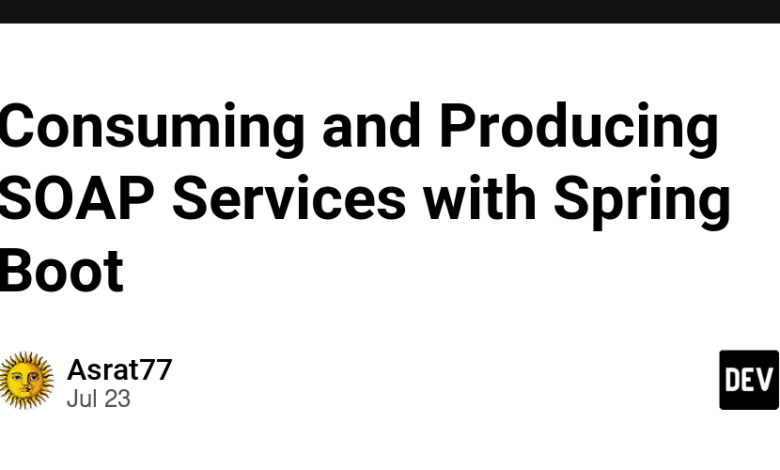مصرف و تولید خدمات صابون با بوت فنری

Summarize this content to 400 words in Persian Lang
راه اندازی پروژه بوت بهار شما
برای شروع، به Spring Initializr بروید. در اینجا، می توانید به سرعت یک پروژه Spring Boot با وابستگی های مورد نیاز خود ایجاد کنید. پروژه خود را با تنظیمات زیر پیکربندی کنید:
پروژه: Maven
زبان: جاوا
بوت بهار: 3.3.0
نسخه جاوا: 17
وابستگی ها:
Spring Data JPA (Java Persistence API)
وب بهار
خدمات وب بهار
PostgreSQL
WSDL (زبان تعریف وب سرویس)
پایداری جاکارتا (در صورت نیاز) #### درک وارونگی کنترل (IoC) و تزریق وابستگی (DI) وارونگی کنترل (IoC) یک اصل اساسی Spring است. به جای اینکه برنامه فریم ورک را فراخوانی کند، فریم ورک اجزای برنامه را فراخوانی می کند. این از طریق Dependency Injection (DI) به دست می آید، که در آن چارچوب به جای اینکه خود کلاس ها وابستگی ایجاد کنند، وابستگی ها را به کلاس ها تزریق می کند. این امر اتصال شل را تقویت می کند و آزمایش پذیری را افزایش می دهد. #### مرحله 1: ایجاد مدل یک کلاس مدل تعریف کنید که ساختار داده برنامه شما را نشان دهد. این کلاس باید رابط Serializable را برای تسهیل سریالسازی و سریالزدایی اشیاء پیادهسازی کند.
@Table(name=”client”)
public class Client implements Serializable {
private static final long serialVersionUID = 1L;
@Id
@Column(name=”id”)
private long id;
// Repeat for other attributes
// Getters and Setters
}
وارد حالت تمام صفحه شوید
از حالت تمام صفحه خارج شوید
توضیحات: کلاس Client یک جدول را در پایگاه داده شما نشان می دهد. با علامت گذاری آن با Entity@ و @Table، آن را به یک نهاد مدیریت شده در JPA تبدیل می کنید.
مرحله 2: ایجاد لایه مخزن
یک رابط ایجاد کنید که JpaRepository را برای ارائه عملیات CRUD برای مدل شما گسترش دهد.
“ وارد کردن com.example.client_mgmt.model.Client;وارد کردن org.springframework.data.jpa.repository.JpaRepository;وارد کردن org.springframework.stereotype.Repository;
@Repositoryرابط عمومی ClientRepository توسعه JpaRepository {}
Description: The ClientRepository interface allows you to perform database operations on the Client entity without writing boilerplate code.
#### Step 3: Creating the Service Layer
Define a service interface and its implementation to manage Client entities, encapsulating business logic.
“`import com.example.client_mgmt.model.Client;
import java.util.List;
import java.util.Optional;
public interface ClientService {
void addClient(Client client);
Optional getClientById(long id);
List getAll();
}
import org.springframework.beans.factory.annotation.Autowired;
import org.springframework.stereotype.Service;
import java.util.List;
import java.util.Optional;
@Service
public class ClientServiceImpl implements ClientService {
@Autowired
private ClientRepository repo;
@Override
public void addClient(Client client) {
repo.save(client);
}
@Override
public Optional getClientById(long id) {
return repo.findById(id);
}
@Override
public List getAll() {
return repo.findAll();
}
}
وارد حالت تمام صفحه شوید
از حالت تمام صفحه خارج شوید
توضیحات: ClientService و ClientServiceImpl منطق تجاری را تعریف و پیاده سازی می کنند و آن را از لایه کنترلر جدا می کنند.
مرحله 4: ساخت Serializer و Deserializer
نمونه های Client را به و از نمونه های SOAP ClientInfo تبدیل کنید.
“ وارد کردن com.example.client_mgmt.model.Client;وارد کردن com.example.client_mgmt.soap.ClientInfo;وارد کردن org.springframework.beans.BeanUtils;
وارد کردن java.util.ArrayList;وارد کردن java.util.List.
کلاس عمومی ClientSerializer {عمومی ClientInfo serialize (Client Client) {ClientInfo clientInfo = new ClientInfo();BeanUtils.copyProperties(client، clientInfo);بازگشت اطلاعات مشتری؛}
public Client deserialize(ClientInfo clientInfo) {
Client client = new Client();
BeanUtils.copyProperties(clientInfo, client);
return client;
}
public List serializeAll(List clients) {
List clientInfos = new ArrayList();
for (Client client : clients) {
clientInfos.add(serialize(client));
}
return clientInfos;
}
وارد حالت تمام صفحه شوید
از حالت تمام صفحه خارج شوید
}
Description: The ClientSerializer class handles the conversion between your Client entity and the SOAP ClientInfo representation.
#### Step 5: Creating the Endpoint
Define an endpoint to handle SOAP requests, mapping them to your service layer.
“`import com.example.client_mgmt.service.ClientService;
import com.example.client_mgmt.soap.*;
import org.springframework.beans.factory.annotation.Autowired;
import org.springframework.ws.server.endpoint.annotation.Endpoint;
import org.springframework.ws.server.endpoint.annotation.PayloadRoot;
import org.springframework.ws.server.endpoint.annotation.RequestPayload;
import org.springframework.ws.server.endpoint.annotation.ResponsePayload;
@Endpoint
public class ClientEndpoint {
private static final String NAMESPACE_URI = “http://example.com/client_mgmt”;
@Autowired
private ClientService service;
@Autowired
private ClientSerializer serializer;
@PayloadRoot(namespace = NAMESPACE_URI, localPart = “getClientsRequest”)
@ResponsePayload
public GetClientsResponse getClients(@RequestPayload GetClientsRequest request) {
GetClientsResponse response = new GetClientsResponse();
List clients = service.getAll();
List clientInfos = serializer.serializeAll(clients);
response.getClients().addAll(clientInfos);
return response;
}
// Additional methods for other operations (e.g., addClient)
}
وارد حالت تمام صفحه شوید
از حالت تمام صفحه خارج شوید
توضیحات: ClientEndpoint درخواستهای SOAP ورودی را پردازش میکند و با تعامل با لایه سرویس، پاسخهای مناسب را برمیگرداند.
مرحله 6: پیکربندی وب سرویس
یک کلاس پیکربندی برای راه اندازی وب سرویس SOAP ایجاد کنید.
“وارد کردن org.springframework.boot.web.servlet.ServletRegistrationBean;وارد کردن org.springframework.context.ApplicationContext;وارد کردن org.springframework.context.annotation.Bean;وارد کردن org.springframework.context.annotation.Configuration.وارد کردن org.springframework.ws.config.annotation.EnableWs.وارد کردن org.springframework.ws.config.annotation.WsConfigurerAdapter.وارد کردن org.springframework.ws.transport.http.MessageDispatcherServlet;وارد کردن org.springframework.ws.wsdl.wsdl11.DefaultWsdl11Definition;وارد کردن org.springframework.xml.xsd.SimpleXsdSchema;وارد کردن org.springframework.xml.xsd.XsdSchema;
@EnableWs@ پیکربندیکلاس عمومی WebServiceConfig گسترش WsConfigurerAdapter {@لوبیاعمومی ServletRegistrationBean messageDispatcherServlet(ApplicationContext applicationContext) {MessageDispatcherServlet servlet = new MessageDispatcherServlet();servlet.setApplicationContext(applicationContext);servlet.setTransformWsdlLocations(true);برگرداندن ServletRegistrationBean جدید (servlet, “/ws/*”);}
@Bean(name = “clients”)
public DefaultWsdl11Definition defaultWsdl11Definition(XsdSchema clientsSchema) {
DefaultWsdl11Definition definition = new DefaultWsdl11Definition();
definition.setPortTypeName(“ClientsPort”);
definition.setLocationUri(“/ws”);
definition.setTargetNamespace(“http://example.com/client_mgmt”);
definition.setSchema(clientsSchema);
return definition;
}
@Bean
public XsdSchema clientsSchema() {
return new SimpleXsdSchema(new ClassPathResource(“clients.xsd”));
}
وارد حالت تمام صفحه شوید
از حالت تمام صفحه خارج شوید
}
Description: WebServiceConfig sets up the SOAP web service, registering the necessary servlet and defining the WSDL.
#### Step 7: Testing with SOAP-UI
Use SOAP-UI to create test requests and responses. This helps in verifying the correctness of your SOAP services.
Description: SOAP-UI is a powerful tool for testing your SOAP services, ensuring they behave as expected.
#### Final Thoughts
Working with SOAP services in Spring Boot involves a series of well-defined steps, from setting up the project to defining the model, repository, service, and endpoint layers. By leveraging Spring’s powerful features like IoC and DI, along with tools like SOAP-UI for testing, you can build robust SOAP web services efficiently.
#### References
– Dependencies: External libraries or modules your Spring application relies on to function. Examples include Spring Data JPA, Spring Security, and Log4j.
– Plugins: Specialized tools that extend your build process, such as the Maven Compiler Plugin and the Spring Boot Maven Plugin.
وارد حالت تمام صفحه شوید
از حالت تمام صفحه خارج شوید
راه اندازی پروژه بوت بهار شما
برای شروع، به Spring Initializr بروید. در اینجا، می توانید به سرعت یک پروژه Spring Boot با وابستگی های مورد نیاز خود ایجاد کنید. پروژه خود را با تنظیمات زیر پیکربندی کنید:
- پروژه: Maven
- زبان: جاوا
- بوت بهار: 3.3.0
- نسخه جاوا: 17
- وابستگی ها:
- Spring Data JPA (Java Persistence API)
- وب بهار
- خدمات وب بهار
- PostgreSQL
- WSDL (زبان تعریف وب سرویس)
- پایداری جاکارتا (در صورت نیاز) #### درک وارونگی کنترل (IoC) و تزریق وابستگی (DI) وارونگی کنترل (IoC) یک اصل اساسی Spring است. به جای اینکه برنامه فریم ورک را فراخوانی کند، فریم ورک اجزای برنامه را فراخوانی می کند. این از طریق Dependency Injection (DI) به دست می آید، که در آن چارچوب به جای اینکه خود کلاس ها وابستگی ایجاد کنند، وابستگی ها را به کلاس ها تزریق می کند. این امر اتصال شل را تقویت می کند و آزمایش پذیری را افزایش می دهد. #### مرحله 1: ایجاد مدل یک کلاس مدل تعریف کنید که ساختار داده برنامه شما را نشان دهد. این کلاس باید رابط Serializable را برای تسهیل سریالسازی و سریالزدایی اشیاء پیادهسازی کند.
@Table(name="client")
public class Client implements Serializable {
private static final long serialVersionUID = 1L;
@Id
@Column(name="id")
private long id;
// Repeat for other attributes
// Getters and Setters
}
توضیحات: کلاس Client یک جدول را در پایگاه داده شما نشان می دهد. با علامت گذاری آن با Entity@ و @Table، آن را به یک نهاد مدیریت شده در JPA تبدیل می کنید.
مرحله 2: ایجاد لایه مخزن
یک رابط ایجاد کنید که JpaRepository را برای ارائه عملیات CRUD برای مدل شما گسترش دهد.
“ وارد کردن com.example.client_mgmt.model.Client;
وارد کردن org.springframework.data.jpa.repository.JpaRepository;
وارد کردن org.springframework.stereotype.Repository;
@Repository
رابط عمومی ClientRepository توسعه JpaRepository {
}
Description: The ClientRepository interface allows you to perform database operations on the Client entity without writing boilerplate code.
#### Step 3: Creating the Service Layer
Define a service interface and its implementation to manage Client entities, encapsulating business logic.
```import com.example.client_mgmt.model.Client;
import java.util.List;
import java.util.Optional;
public interface ClientService {
void addClient(Client client);
Optional getClientById(long id);
List getAll();
}
import org.springframework.beans.factory.annotation.Autowired;
import org.springframework.stereotype.Service;
import java.util.List;
import java.util.Optional;
@Service
public class ClientServiceImpl implements ClientService {
@Autowired
private ClientRepository repo;
@Override
public void addClient(Client client) {
repo.save(client);
}
@Override
public Optional getClientById(long id) {
return repo.findById(id);
}
@Override
public List getAll() {
return repo.findAll();
}
}
توضیحات: ClientService و ClientServiceImpl منطق تجاری را تعریف و پیاده سازی می کنند و آن را از لایه کنترلر جدا می کنند.
مرحله 4: ساخت Serializer و Deserializer
نمونه های Client را به و از نمونه های SOAP ClientInfo تبدیل کنید.
“ وارد کردن com.example.client_mgmt.model.Client;
وارد کردن com.example.client_mgmt.soap.ClientInfo;
وارد کردن org.springframework.beans.BeanUtils;
وارد کردن java.util.ArrayList;
وارد کردن java.util.List.
کلاس عمومی ClientSerializer {
عمومی ClientInfo serialize (Client Client) {
ClientInfo clientInfo = new ClientInfo();
BeanUtils.copyProperties(client، clientInfo);
بازگشت اطلاعات مشتری؛
}
public Client deserialize(ClientInfo clientInfo) {
Client client = new Client();
BeanUtils.copyProperties(clientInfo, client);
return client;
}
public List serializeAll(List clients) {
List clientInfos = new ArrayList();
for (Client client : clients) {
clientInfos.add(serialize(client));
}
return clientInfos;
}
}
Description: The ClientSerializer class handles the conversion between your Client entity and the SOAP ClientInfo representation.
#### Step 5: Creating the Endpoint
Define an endpoint to handle SOAP requests, mapping them to your service layer.
```import com.example.client_mgmt.service.ClientService;
import com.example.client_mgmt.soap.*;
import org.springframework.beans.factory.annotation.Autowired;
import org.springframework.ws.server.endpoint.annotation.Endpoint;
import org.springframework.ws.server.endpoint.annotation.PayloadRoot;
import org.springframework.ws.server.endpoint.annotation.RequestPayload;
import org.springframework.ws.server.endpoint.annotation.ResponsePayload;
@Endpoint
public class ClientEndpoint {
private static final String NAMESPACE_URI = "http://example.com/client_mgmt";
@Autowired
private ClientService service;
@Autowired
private ClientSerializer serializer;
@PayloadRoot(namespace = NAMESPACE_URI, localPart = "getClientsRequest")
@ResponsePayload
public GetClientsResponse getClients(@RequestPayload GetClientsRequest request) {
GetClientsResponse response = new GetClientsResponse();
List clients = service.getAll();
List clientInfos = serializer.serializeAll(clients);
response.getClients().addAll(clientInfos);
return response;
}
// Additional methods for other operations (e.g., addClient)
}
توضیحات: ClientEndpoint درخواستهای SOAP ورودی را پردازش میکند و با تعامل با لایه سرویس، پاسخهای مناسب را برمیگرداند.
مرحله 6: پیکربندی وب سرویس
یک کلاس پیکربندی برای راه اندازی وب سرویس SOAP ایجاد کنید.
“وارد کردن org.springframework.boot.web.servlet.ServletRegistrationBean;
وارد کردن org.springframework.context.ApplicationContext;
وارد کردن org.springframework.context.annotation.Bean;
وارد کردن org.springframework.context.annotation.Configuration.
وارد کردن org.springframework.ws.config.annotation.EnableWs.
وارد کردن org.springframework.ws.config.annotation.WsConfigurerAdapter.
وارد کردن org.springframework.ws.transport.http.MessageDispatcherServlet;
وارد کردن org.springframework.ws.wsdl.wsdl11.DefaultWsdl11Definition;
وارد کردن org.springframework.xml.xsd.SimpleXsdSchema;
وارد کردن org.springframework.xml.xsd.XsdSchema;
@EnableWs
@ پیکربندی
کلاس عمومی WebServiceConfig گسترش WsConfigurerAdapter {
@لوبیا
عمومی ServletRegistrationBean messageDispatcherServlet(ApplicationContext applicationContext) {
MessageDispatcherServlet servlet = new MessageDispatcherServlet();
servlet.setApplicationContext(applicationContext);
servlet.setTransformWsdlLocations(true);
برگرداندن ServletRegistrationBean جدید (servlet, “/ws/*”);
}
@Bean(name = "clients")
public DefaultWsdl11Definition defaultWsdl11Definition(XsdSchema clientsSchema) {
DefaultWsdl11Definition definition = new DefaultWsdl11Definition();
definition.setPortTypeName("ClientsPort");
definition.setLocationUri("/ws");
definition.setTargetNamespace("http://example.com/client_mgmt");
definition.setSchema(clientsSchema);
return definition;
}
@Bean
public XsdSchema clientsSchema() {
return new SimpleXsdSchema(new ClassPathResource("clients.xsd"));
}
}
Description: WebServiceConfig sets up the SOAP web service, registering the necessary servlet and defining the WSDL.
#### Step 7: Testing with SOAP-UI
Use SOAP-UI to create test requests and responses. This helps in verifying the correctness of your SOAP services.
Description: SOAP-UI is a powerful tool for testing your SOAP services, ensuring they behave as expected.
#### Final Thoughts
Working with SOAP services in Spring Boot involves a series of well-defined steps, from setting up the project to defining the model, repository, service, and endpoint layers. By leveraging Spring’s powerful features like IoC and DI, along with tools like SOAP-UI for testing, you can build robust SOAP web services efficiently.
#### References
- Dependencies: External libraries or modules your Spring application relies on to function. Examples include Spring Data JPA, Spring Security, and Log4j.
- Plugins: Specialized tools that extend your build process, such as the Maven Compiler Plugin and the Spring Boot Maven Plugin.



